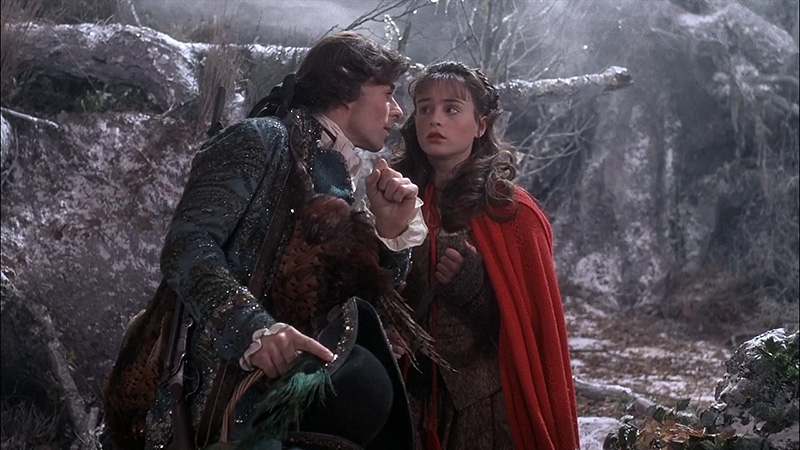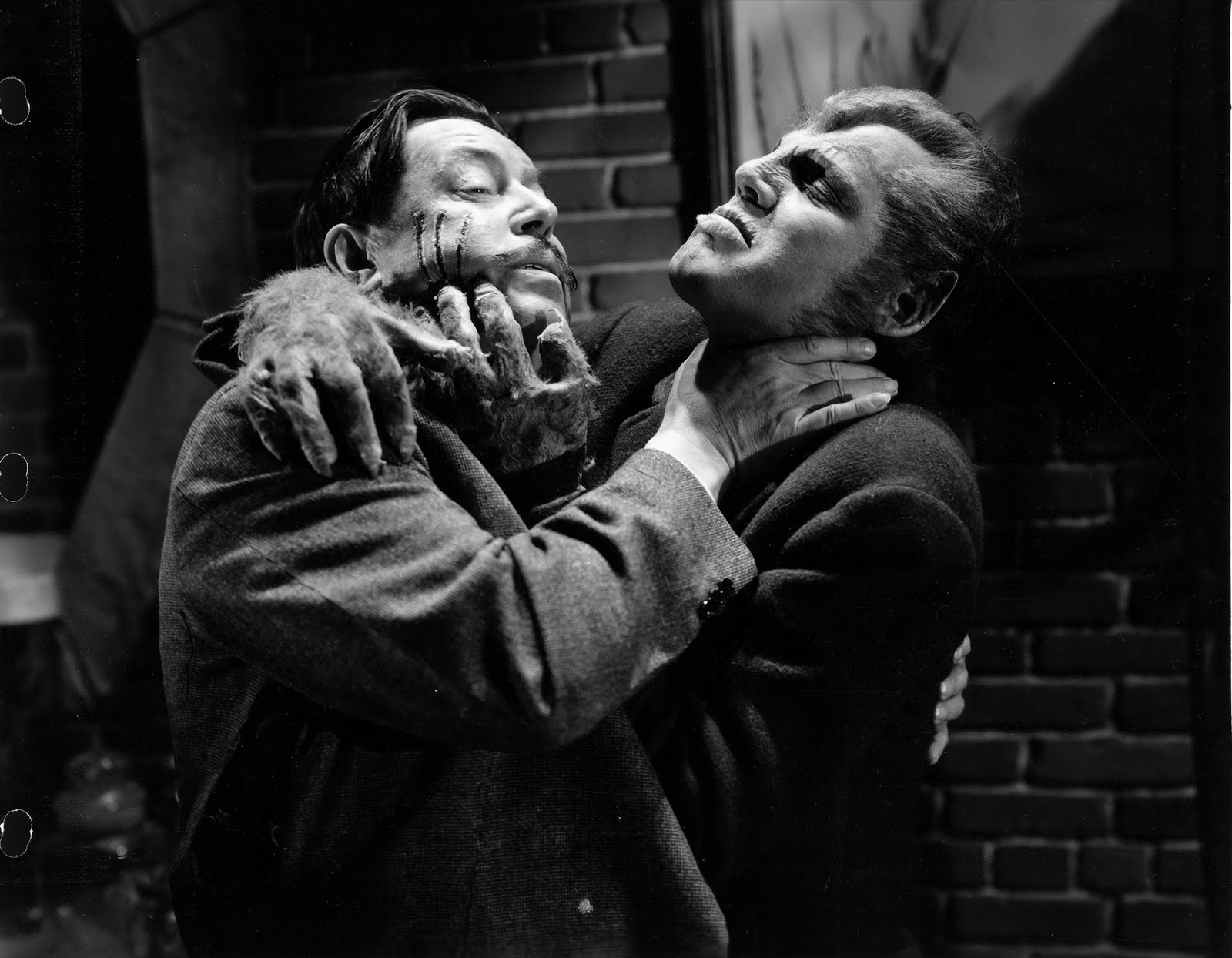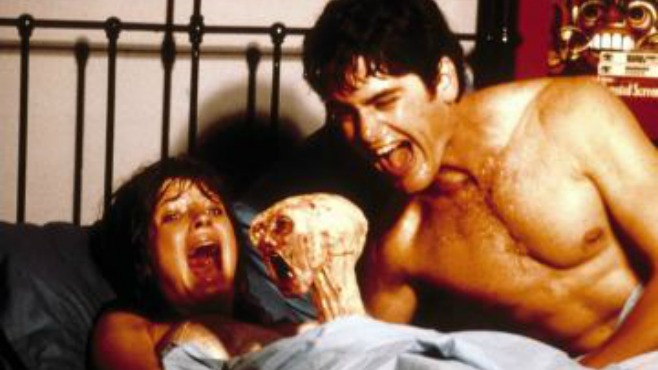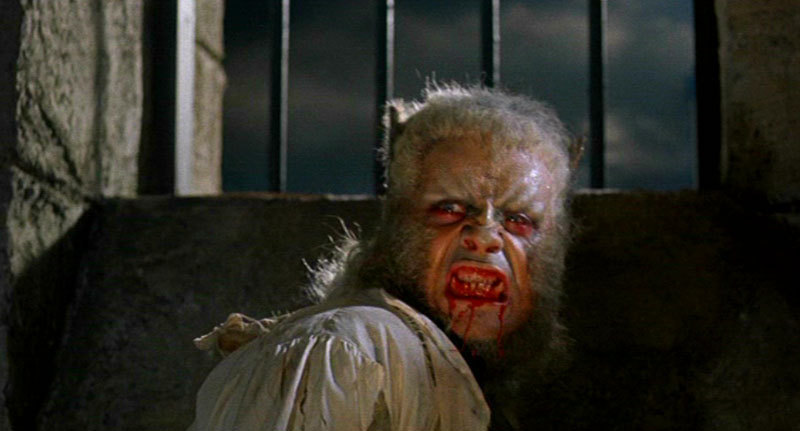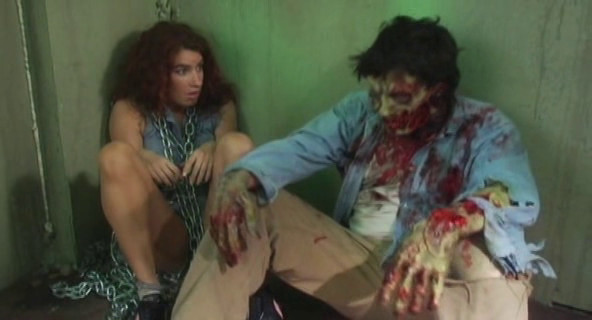6. The Company of Wolves (1984)
Much like Brotherhood of the Wolf, this 1984 Neil Jordan film does away with a contemporary setting and disregards the clichés established in the wake of Universal’s 1941 monster success . Instead, The Company of Wolves focuses on a time of fables and villages, when little girls were warned to be weary of men whose eyebrows met in the middle.
Although centered around the young protagonist, Rosaleen, the film is essentially an anthology comprised of different tales related to Bela Lugosi’s children of the night. These stories are well varied, ranging from an abandoned mother seeking revenge on a wealthy aristocrat to a young man who encounters a devilish businessman in a dark forest.
The greatest defining characteristic to The Company of Wolves is its fairy-tale wrappings. Established through impressive sets, a spellbinding score and storybook aesthetic , this tone helps to provide the film with a sense of fantasy that’s noticeably absent from the competition.
But intended for children, this film is not. Even with a PG-13 rating, The Company of Wolves has rather terrifying imagery including yellow eyes piercing through the darkness, as well as an elongated tongue protruding from a man’s mouth. There’s also a particularly gruesome transformation scene where a man rips off his own skin, meaty flesh exposed, and proceeds to change before a mother and her screaming infants. Like many other fantasy films of the 1980’s, The Company of Wolves is very dark escape from reality.
7. Werewolf of London (1935)
Just as 1931’s Frankenstein and Dracula were not the first instances of giving Mary Shelly and Bram Stoker’s literary works the cinematic treatment, so too was The Wolf Man not the first werewolf movie. Released in 1935, Werewolf of London opens with botanist Wilfred Glendon trekking through Tibet in search of a rare plant. During his expedition Glendon is attacked. Upon returning to London with his specimen, Glendon realizes the plant might be his only hope for curing his newfound transformations and prevent himself from killing his beloved.
Having been made over seventy years ago, Wolf of London is expectedly dated, from the music to the acting. Cinema as a whole has come a long way since the 1930’s, so to compare the film to the more recent examples of this list would be to put it at unfair disadvantage. While it may not have withstood the test of time, the Wolf of London’s age is largely what gives the film its charm. Much like the other horror films of the time, Werewolf of London is beautiful, comprised of sets featuring fancy architecture and drenched in black and white tones.
Also, like its more popular siblings, the film’s make-up and effects were executed by the talented Jack Pierce who was responsible for constructing some of the most recognizable monsters in all of cinema. Released long before the advancement of practical effects during the eighties, this pre-Wolf Man title features three distinct transformation techniques, making it a milestone in werewolf effects.
8. The Howling 3 (1987)
Although labeled as the second sequel to The Howling, director Phillipe Mora’s entry in the franchise is largely unrelated to the 1981 original. Eagerly determined to find proof of the existence of actual lycanthropy, Professor Harry Beckmeyer aids in discovering an isolated subspecies of humans living in the Australian outback. Whereas Beckmeyer is fascinated by his discovery, his fellow scientists are frightened and insistent upon the species demise. Reluctant to be involved in the extermination, Beckmeyer helps his desperate subjects escape civilization and return to the wild.
Like its immediate predecessor, The Howling 3 doesn’t adhere to the level of quality established in the first film. With less-than-believable make-up, cheesy dialogue and a messy narrative, the film comes off as being silly in spite the intentions of its cast and crew. Even with the unintentional spurts of humor, The Howling 3 still manages to make the noblest of effort: promoting wildlife preservation. Using actual stock footage of the now extinct Tasmanian wolf, this core theme helps the film to transcend its wackier elements and become something of a unique take on the feral horror subgenre.
9. The Curse of the Werewolf (1961)
Hammer Films, a British production company, is best remembered for their popular rebirth of the Frankenstein and Dracula films during the 1950’s and 1960’s. Overshadowed by these successes was their The Curse of the Werewolf from 1961. Set in eighteenth century Spain, a mute woman is raped and later births a son on Christmas day.
The mother dies and the child is cursed to turn into a wolf every full moon. The boy, Leon, knows nothing of his ailment under the protection and love of his adopted parents. Eventually Leon sets out to make his own way in the world, only to discover his secret past the hard way and go on a good old monster romp in the neighboring town.
In true Hammer fashion, The Curse of the Werewolf features fanciful sets and costumes that aid in creating a visually extravagant soap opera. But one of the strongest points of Hammer’s color remakes was the inclusion of horror legends Christopher Lee and Peter Cushing. Unfortunately, The Curse of the Werewolf noticeably lacks the commanding presence of both actors. Filling this void, however, is a young Oliver Reed who gives a memorable and over-the-top performance that fluctuates between quick whispers and manic screams.
10. A Werewolf in a Women’s Prison (2006)
Despite being the most recent film on the list, A Werewolf in a Women’s Prison is arguably the most obscure: Sarah and her boyfriend Zack decide to go camping in the Mexican wilderness, and as luck would have it, the two are attacked by the beast of legend. Accused for Zack’s death, the unconscious Sarah awakens to find herself a prisoner in a Mexican penitentiary for women, ruled by a S&M obsessed warden. As she tries to survive in her new hostile environment, Sarah must come to terms with her monstrous new self and plan an escape from her oppressors.
Contrary to the serious synopsis above, A Werewolf in a Women’s Prison more closely resembles a contemporary exploitation film with a carefree tone. It’s ripe with gratuitous nudity, unconvincing acting, and low-grade effects. At times the film borders on being softcore porn, with irrelevant sex scenes such as one in which Sarah and another inmate lick the sweat off each others’ bodies to keep from dehydration. But nudity and sex are not key ingredients to a horror film: suspense, blood and death are the staples which hold the genre together.
A Werewolf in a Women’s Prison may be devoid of any real suspense, but it sure does deliver on bloody deaths, even if said deaths are hilarious. For example, one nude prisoner has the misfortunate of comically being pulled through cell bars like string cheese by the rampaging Sarah. In short, A Werewolf in a Women’s Prison offers a viewing experience that’s so bad, it’s great.
Author Bio: To the general public, Cody is a nobody working as a cashier for a local supermarket. Underneath his unsuspecting exterior, however, lies a student of film with aspirations to partake in film production. With an interest in the horror genre, some of Cody’s favorite directors include Guillermo Del Toro, James Gunn, David Fincher, John Carpenter, and Jean-Pierre Jeunet.
